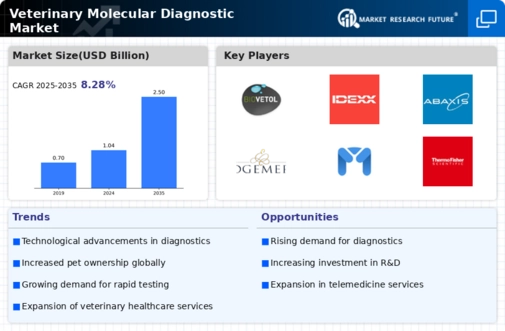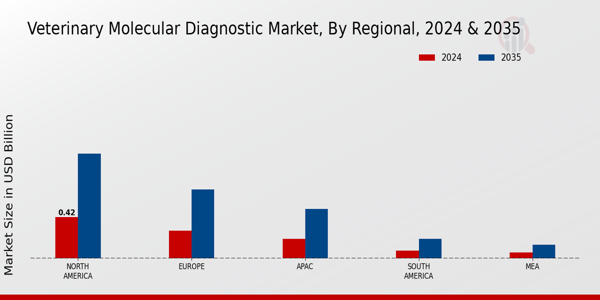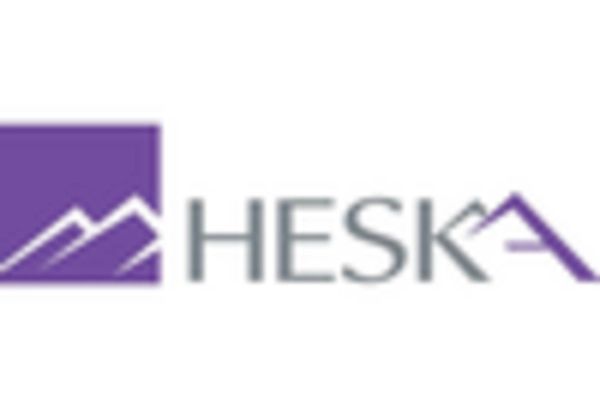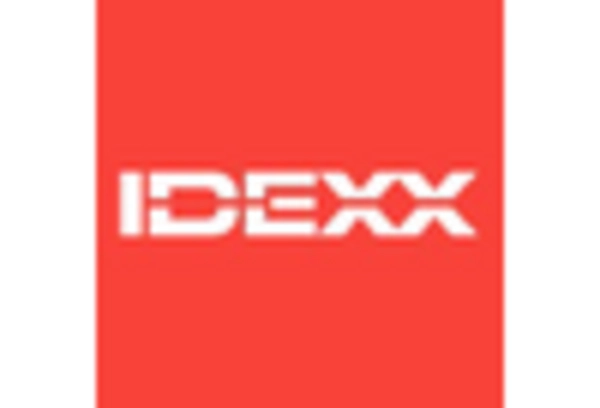Increased Focus on Preventive Care
The Veterinary Molecular Diagnostic Market is witnessing a paradigm shift towards preventive care, which is reshaping the landscape of veterinary medicine. As pet owners become more aware of the importance of early disease detection, there is a growing demand for molecular diagnostic tools that can identify potential health issues before they escalate. This trend is supported by data indicating that preventive care can significantly reduce long-term veterinary costs and improve the quality of life for pets. Consequently, veterinary practices are increasingly adopting molecular diagnostics as part of routine health assessments, thereby driving market growth. The emphasis on preventive care is likely to continue, further solidifying the role of molecular diagnostics in veterinary medicine.
Growing Awareness of Zoonotic Diseases
The Veterinary Molecular Diagnostic Market is increasingly shaped by the growing awareness of zoonotic diseases, which are diseases that can be transmitted from animals to humans. This heightened awareness has led to a greater emphasis on the need for effective diagnostic tools that can quickly identify pathogens in animals, thereby preventing potential outbreaks. The market is responding to this demand by developing molecular diagnostic tests that are specifically designed to detect zoonotic pathogens. Data suggests that the incidence of zoonotic diseases is on the rise, prompting both veterinary professionals and public health officials to prioritize the use of molecular diagnostics. This trend is likely to drive further investment in the Veterinary Molecular Diagnostic Market, as stakeholders recognize the critical role of diagnostics in safeguarding public health.
Regulatory Support and Standardization
The Veterinary Molecular Diagnostic Market is benefiting from enhanced regulatory support and standardization efforts aimed at improving diagnostic practices. Regulatory bodies are increasingly recognizing the importance of molecular diagnostics in veterinary medicine, leading to the establishment of guidelines that promote their use. This regulatory framework not only ensures the safety and efficacy of diagnostic tests but also fosters innovation within the industry. As a result, veterinary practices are more inclined to adopt molecular diagnostic tools, knowing they meet established standards. The ongoing development of regulatory policies is expected to further facilitate market growth, as it encourages the integration of advanced diagnostic technologies into routine veterinary care.
Technological Advancements in Diagnostics
The Veterinary Molecular Diagnostic Market is experiencing a surge in technological advancements that enhance diagnostic accuracy and speed. Innovations such as next-generation sequencing and real-time PCR are becoming increasingly prevalent, allowing for the rapid identification of pathogens in animals. These technologies not only improve the efficiency of diagnostics but also reduce the time required for results, which is crucial in clinical settings. The market for molecular diagnostics in veterinary medicine is projected to grow significantly, with estimates suggesting a compound annual growth rate of over 10% in the coming years. This growth is driven by the need for precise diagnostics that can lead to better treatment outcomes and improved animal health management.
Rising Pet Ownership and Humanization of Pets
The Veterinary Molecular Diagnostic Market is significantly influenced by the rising trend of pet ownership and the humanization of pets. As more households welcome pets into their lives, there is an increasing expectation for high-quality veterinary care that mirrors human healthcare standards. This trend has led to a heightened demand for advanced diagnostic tools, including molecular diagnostics, which are essential for accurate disease detection and management. Market data indicates that pet ownership rates have increased substantially, with estimates suggesting that over 70% of households in certain regions now own pets. This growing demographic is likely to drive the demand for veterinary molecular diagnostics, as pet owners seek comprehensive health solutions for their animals.


















Leave a Comment